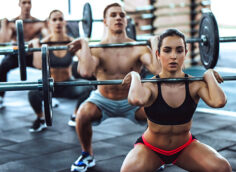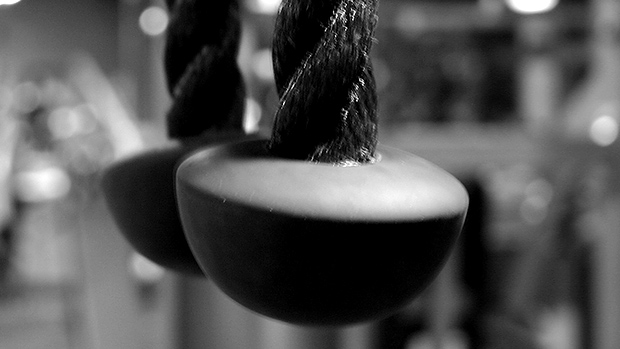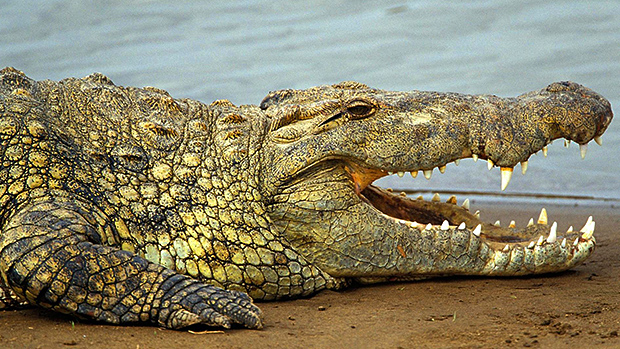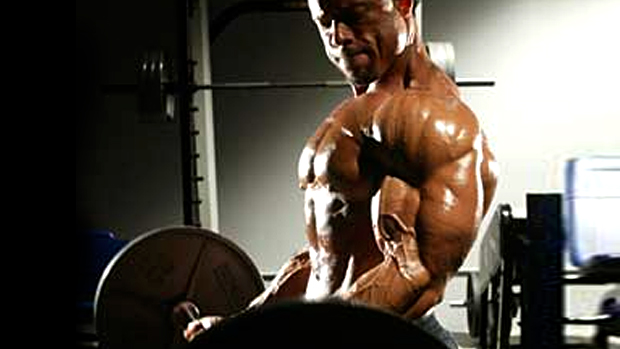The lunge is one of the best exercises you can do in the gym.
Unfortunately, the performance of the "lunge" by your
average gym-goer is about as baffling as nipples on men. Some
things just don't add up.
Whether your goal is improved performance, wheels of steel, or a
bigger total, lunges can help get you there. The lunge may not be
as sexy as a big squat or deadlift, but once you've learned to
lunge effectively it's one of the most potent exercises you
can employ in your weight-training arsenal.
 |
Why Lunge?
Multiple authors have outlined the basic or primal movement
patterns. In case your aren't familiar with these, here's
the short list:
Squatting
Bending
Lunging
Pushing
Pulling
Twisting
Gait
The lunge is an amazing exercise for many reasons. Firstly, you
need little, if any, equipment to perform lunges. Even if you only
have a 5'x5' exercise space, lunges are an
option.
Another great aspect of the lunge is that it lends itself well
to progression. With a squat or deadlift the best way to
"progress" is to add weight. With the lunge, there are a
whole host of progressions and variations you can use to
continually challenge yourself.
Finally, a few years ago in my Single Leg Supplements article,
I discussed how lunges are great for balancing strength between
legs and developing the entire thigh.
The bottom line is this: lunges are a great exercise and deserve
to be done correctly. Let's learn how to do them properly
first and foremost.
A Brief Rant
I'd like to rant for a second here: too many people
(coaches, personal trainers, and even casual Testosterone readers)
are way too focused on writing a sexy training program. There, I
said it. Quit worrying about programming until you know how to do
the damn lifts!
Instead, more attention needs to be focused on improving
movement skills – making sure the execution of all lifts is
flawless. If you're a personal trainer or coach, you know what
sexy programming gets you when a kid can't do the lift, right?
It gets you:
A) A jacked-up kid
B) A lawsuit
C) Taken for everything you're worth (including your
Spiderman comic book collection)
D) All of the above
If you answered D, you're figuring things out. Seriously,
good programming is great, but it's nothing if you can't
perform the lifts properly. Hopefully articles like this one will
help!
Performance
Let's examine what a good, solid lunge looks like. Chances
are you've seen people try to lunge more than a few times, but
very rarely is it a clean, crisp lift. We'll use the standard
dynamic lunge for our explanation.
To properly perform a lunge, start with an upright posture. One
of the best cues you can use here is to make yourself
"tall," as this simultaneously improves posture and
activates the core musculature. Once we've achieved this
posture, take an exaggerated step out, landing softly on your heel.
Lower under control to a point where your back knee is just
above (but not touching!) the ground. Keeping the core tight, drive
back off the heel to the starting position. While it can be very
technical when approached properly, a good lunge should look smooth
and effortless.
<!--
-->
Performance Minutiae
Two issues that are often brought up when lunging are the stride
length and the propulsion point. Changing these two items radically
changes the targeted areas.
Stride Length – The shorter your stride, the more quad-dominant
you'll make the movement. There's an increased need for
dorsiflexion at the ankle, and there's going to be a relative
decrease in knee flexion (e.g. you won't go as deep). Both
these add up to more quad-work.
On the flip side, a longer stride will decrease dorsiflexion at the
ankle and increase the relative amount of flexion at the knee. In
essence, you'll go "deeper," increasing activation
of the posterior chain (glutes and hammies).
Propulsion Point – The same rules apply for the propulsion
point. If you push off from the mid-foot to the forefoot,
you're going to increase relative loading on the anterior
chain. If you push through your heel, you're going to increase
relative loading on the posterior chain.
For consistency purposes, I use the heel propulsion point example
throughout this article, but utilize the version that best helps
you achieve your goals.
Here's are two final examples to clarify this
concept:
1. A long-stride lunge where your propulsion point is the heel
will be a very hip-dominant movement.
 |
2. A short-stride lunge where your propulsion point is the
mid-foot will be a very quad-dominant movement.
 |
Now that we've covered what a good lunge is supposed to
look like, let's examine some of the common flaws, as well as
how to fix them.
Common Flaws
When we're talking about lunging we want to focus on clean,
crisp, and efficient movements. This is actually far from the norm!
Here's a short list of the most common errors I see in the
gym:
Error #1: Forward Lean
 |
You'll see this quite often in people who are tight in
their hip flexors/quads or are very quad dominant. You may need to
do some static stretching of the hip flexors prior to performing
the movement, along with glute activation work.
If you're really having issues with this, you may want to
pair a psoas/rectus femoris stretch with a glute bridge, then
immediately move into your lunge. This will help ensure proper
neural drive to the glutes and posterior chain.
Good coaching cues to break this habit include keeping the chest
up throughout the movement and resetting yourself between reps if
necessary. With some people it's an actual structural issue
(as in the above example), where as with others it's either
being lazy or not using the correct cues. Reset and think
"tall" before each and every rep.
Error #2: Knee Caves In
This is a very common issue in people with weak glutes, so
I'm going to spend a little extra time on it.
When we lunge and are forced to absorb/create force on one leg,
we're immediately challenging our gluteals to provide
stability and strength in the frontal and transverse planes.
When our glutes are inactive (or simply not strong enough), we
can't properly decelerate hip adduction/internal rotation, and
therefore our knees cave in.
 |
To clean this up, start by performing some glute activation work
immediately before lunging – hip corrections, supine clams,
and mini-band/X-band walks are all good choices. One set on the
weak hip should be sufficient; after all, the goal here is neural
activation, not gluteal exhaustion.
Another option requires either a partner or a squat rack. Start
by tying the band around the squat rack at approximately knee
height, and then step through the band placing it just below the
knee. If we're going to lunge with our left leg, we want the
band on the right side of our body so it's pulling our knee
toward the midline of our body.
This may sound counterintuitive, but this pull into
adduction/internal rotation is going to challenge our glutes to
counteract this force and produce the proper movement
pattern.
<!--
-->
Coaching cues include keeping the core tight, landing on the
heel, landing under control, and keeping the majority of the
pressure on the back/outside of the foot.
Error #3: Foot Caves In
Typically if someone's knee caves in, his foot caves in as
well. In geek speak, he overpronates at the foot.
 |
Excessive pronation is typically due to a muscle imbalance
around the lower leg. Specifically, the gastrocnemius, soleus
and/or peroneals are short/stiff and the tibialis anterior is weak.
Some static stretching and foam rolling for the short/stiff
muscles, coupled with an activation set for the tibialis anterior,
could go a long way to correcting this flaw.
If you have no clue what soft-tissue work is, check out Feel
Better for 10 Bucks or Soft Tissue Work
for Tough Guys.
Error #4: Lands on Toes/Produces Force From Toes
Again, this is typically due to muscular imbalance around the
hip/thigh. Upon landing the glutes and hamstrings are forced to
decelerate the body's movement into hip flexion; when they
aren't strong enough, the quads are required to take on the
additional load.
As well, when returning to the starting position, a weak
posterior chain isn't going to be able to produce the force
necessary to get you back up, so again the quads are called upon to
pick up the slack.
Please hear me out on this quick tangent as well. I understand
that earlier I described pushing off from the toes as being a way
to increase quad loading; however, what's good for quad
loading may not be good for knee health. I'd prefer a mid-foot
propulsion point to ensure that you're hitting the quads
without grinding your knee joints into oblivion. Thank you, tangent
over.
So what's the easy answer here? Get your posterior chain
stronger! If it's a technical issue, cue yourself to keep the
weight shifted toward your mid-foot/heels and you'll be
golden.
Progressions
Lunges are great because athletes and clients of virtually any
capacity can perform some variation of them. With that said, it
helps to have a progression that you can follow. Just because there
are a ton of options doesn't mean you're ready for
them!
There are two basic ways to progress on the
lunge:
1) Type of lunge
2) Use and placement of external loading
Let's examine both and the progressions that I use with my
clients and athletes.
Type of Lunge
The type of lunge is actually the easiest way to dictate proper
performance; after all, if you can't do the lowest level correctly, why are you using external load?
Here's the progression that I'm currently
using:
Static lunge –> Reverse Lunge –> Dynamic
Lunge –> Walking Lunge
By starting with the static lunge, we minimize the areas that
people can screw up and allow ourselves to focus on proper movement
quality. Hey, you're really just moving up and down from the
starting position, so this is an ideal place to
start.
The next step is a reverse lunge. In this variation, you keep
your plant leg in place while taking a step backward.
<!--
-->
After we've mastered the reverse lunge, the dynamic lunge
is a big step forward (literally and figuratively). Now we're
really challenging our body to absorb and produce force in all
three planes of movement.
<!--
-->
Finally, the walking lunge brings it all together. We're
absorbing more force than the dynamic lunge, and we're
required to produce more force so we take our body into the next
lunge in a smooth and seamless fashion.
<!--
-->
Use and Placement of External Loading
After mastering the bodyweight variations, it's time to
crank things up a notch with external loading (adding weight).
Here's the progression I use:
Bodyweight –> Dumbbells –> Barbells –> Overhead
Variations
Dumbbells are the first step in external loading. They add
external load, but keep our center of gravity low.
 |
Barbells impose a significantly greater degree of difficulty
than dumbbells for two reasons: 1) You can use more weight with a
barbell than you can a dumbbell, and 2) It raises your center of
gravity, requiring better balance and body control.
 |
Finally, overhead variations pose great demand on the body due
to an even further increase in center of gravity, but the loading
is typically less than a traditional barbell variation.
 |
 |
If you're an athlete who has a penchant for impeccable
balance, want to find different ways to challenge yourself in
training, or simply want to get the attention of the sassy vixen on
the Stairmaster, feel free to incorporate overhead variations in
your routine. If not, the cost-to-benefit ratio of including
overhead lunges in your program is probably in
question.
Summary
If you aren't lunging properly, why the hell are you
lunging at all? Leave your ego at the door, do it right, and reap
the rewards that a beautiful lunge can do for your performance and
physique!




